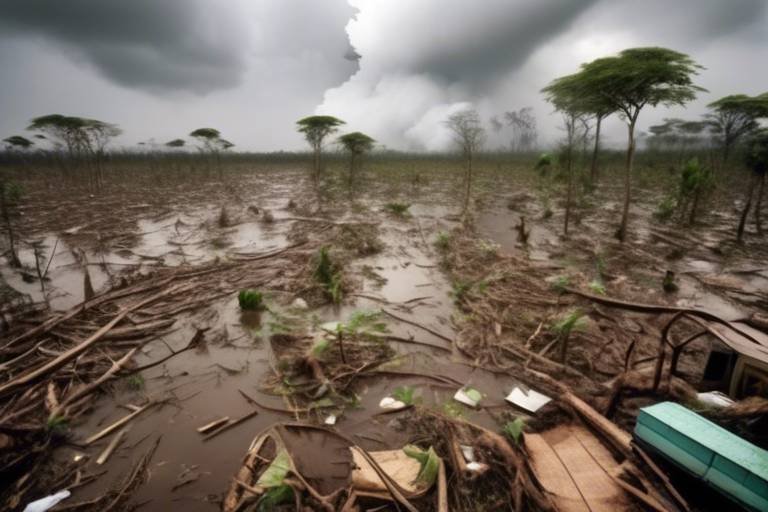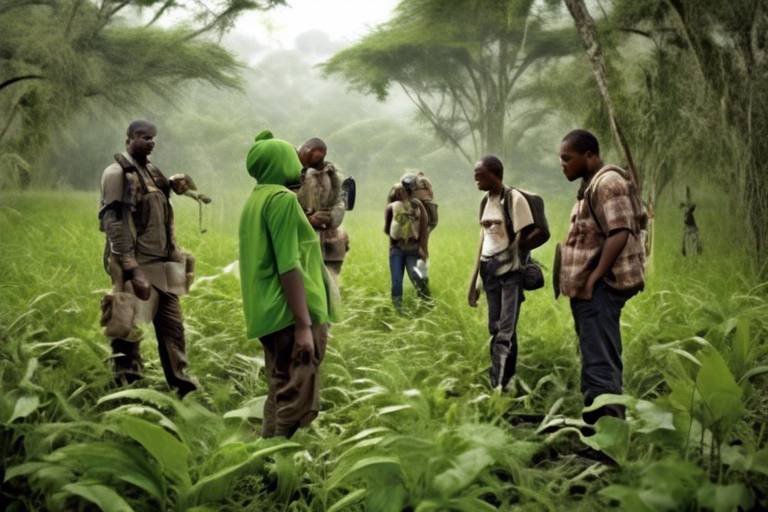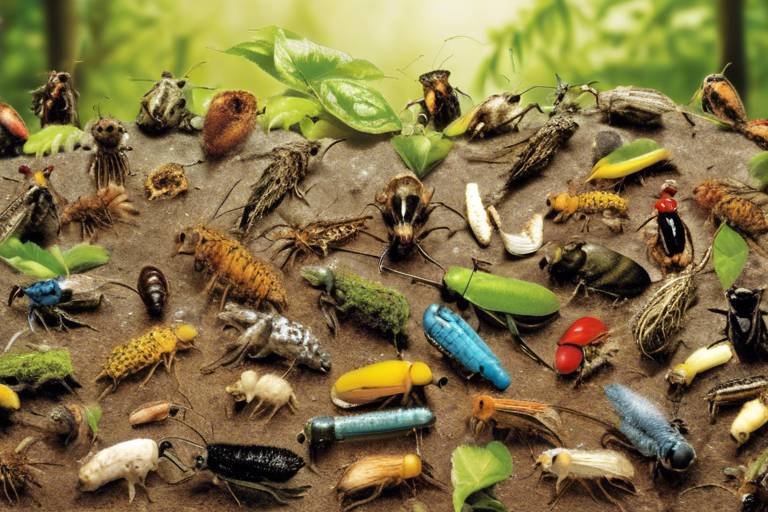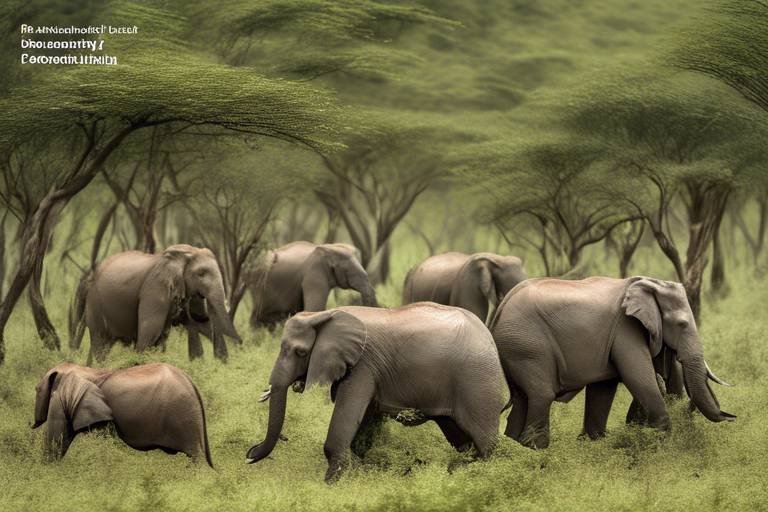The Role of Biodiversity in Mitigating Natural Disasters
Biodiversity is not just a buzzword; it’s a lifeline for our planet, especially when it comes to facing the inevitable challenges posed by natural disasters. Imagine a world where diverse ecosystems act as shields against floods, droughts, and storms. This article delves into how biodiversity contributes to disaster resilience, emphasizing its critical role in maintaining ecosystem stability, aiding climate adaptation, and protecting communities from the devastating impacts of natural hazards. When we think about biodiversity, we often picture vibrant rainforests or coral reefs, but its significance extends far beyond aesthetic beauty. It’s about survival—our survival.
Biodiversity encompasses the variety of life forms within ecosystems, including species diversity, genetic diversity, and ecosystem diversity. Each of these components plays a crucial role in maintaining ecological balance and resilience. Think of biodiversity as a complex tapestry where each thread represents a different species, all interwoven to create a robust and resilient fabric. When one thread is pulled too hard or removed, the entire tapestry can unravel, leading to ecological instability. This intricate web of life not only sustains ecosystems but also provides essential services that are vital for human existence.
Ecosystems provide essential services that can significantly reduce the impact of natural disasters and enhance community resilience. These services include flood regulation, soil stabilization, and carbon sequestration, each playing a pivotal role in safeguarding human lives and properties. For example, wetlands act as natural sponges, absorbing excess water during heavy rainfall, while forests stabilize soil and prevent erosion. When we consider the cost of rebuilding after a disaster, investing in biodiversity and the services it provides can be seen as a proactive approach to disaster risk reduction.
Wetlands and forests act as natural buffers, absorbing excess water during heavy rainfall, thereby reducing flood risks and protecting human settlements from potential damage. These ecosystems are not just passive players; they actively work to mitigate disaster impacts. For instance, wetlands serve as natural sponges, filtering pollutants and absorbing floodwaters, which helps maintain water quality and reduces the severity of flooding events. Similarly, forest canopies intercept rainfall, allowing water to gradually infiltrate the soil, minimizing runoff and erosion. This process is crucial in decreasing the likelihood of landslides and floods, ultimately saving lives and property.
Wetlands are nature's water management systems. They filter pollutants, improve water quality, and absorb floodwaters, acting like a sponge during heavy rains. The importance of wetlands cannot be overstated; they are essential for maintaining ecological balance and protecting communities from the adverse effects of flooding. By preserving and restoring these vital ecosystems, we can enhance our collective resilience against natural disasters.
Forest canopies play a significant role in intercepting rainfall. When rain falls, the leaves and branches of trees catch a portion of it, allowing the water to gradually infiltrate the soil rather than rushing off and causing erosion. This natural process minimizes runoff and helps maintain soil integrity, which is critical during heavy rain events. The more diverse the forest, the more effective it is in managing water flow and preventing disasters.
Diverse plant roots stabilize soil, preventing erosion during heavy rain and wind events. This is critical for maintaining land integrity and reducing disaster risks. When a variety of plants are present, their root systems work together, holding the soil in place and creating a resilient landscape that can withstand extreme weather. Without this diversity, the land becomes vulnerable, leading to increased erosion and greater risk of landslides.
Biodiversity enhances ecosystems' ability to adapt to climate change, helping to mitigate extreme weather events and their associated impacts on communities and infrastructure. As our climate continues to change, the resilience offered by diverse ecosystems becomes increasingly vital. Certain species exhibit resilience to climate variations, contributing to ecosystem stability and enabling habitats to withstand and recover from disturbances caused by natural disasters. This adaptability is essential for ensuring that our natural systems can continue to provide the services we rely on.
Some species demonstrate remarkable resilience to climate variations, playing a crucial role in maintaining ecosystem stability. These resilient species can thrive in changing conditions, helping to sustain the ecosystem's functions and services. For example, native plants often have adapted to local climatic conditions and can better withstand droughts or floods than non-native species. By fostering the growth of these resilient species, we can enhance the overall stability of our ecosystems and, in turn, our communities.
Restoring degraded habitats can significantly enhance biodiversity, improving ecosystem functions that are crucial for mitigating the effects of climate-related disasters. Restoration efforts not only bring back native species but also help in re-establishing the natural processes that protect against disasters. By investing in habitat restoration, we are essentially investing in our future resilience against the impacts of climate change.
Involving local communities in biodiversity conservation fosters awareness and stewardship, empowering them to leverage natural resources for disaster risk reduction and sustainable development. When communities understand the value of biodiversity and actively participate in its conservation, they become better equipped to face the challenges posed by natural disasters. This engagement can take many forms, from community-led restoration projects to educational programs that highlight the importance of maintaining healthy ecosystems.
Educational programs about the importance of biodiversity can encourage communities to actively participate in conservation efforts, ultimately enhancing their resilience to natural disasters. By raising awareness and providing knowledge, we can empower individuals to take action in protecting their environment. This grassroots approach not only strengthens community bonds but also creates a culture of stewardship that is essential for long-term sustainability.
Promoting sustainable land-use practices helps maintain biodiversity, ensuring ecosystems continue to provide essential services that protect communities from disasters. Sustainable practices, such as agroforestry, permaculture, and organic farming, not only enhance biodiversity but also improve soil health and water management. When communities adopt these practices, they not only safeguard their environment but also create a buffer against the impacts of natural disasters.
- How does biodiversity help in disaster mitigation? Biodiversity enhances ecosystem resilience, providing essential services like flood regulation and soil stabilization that protect communities from natural disasters.
- What role do wetlands play in disaster resilience? Wetlands act as natural sponges, absorbing excess water and filtering pollutants, which helps reduce the severity of flooding events.
- Can restoring habitats improve community resilience? Yes, restoring degraded habitats enhances biodiversity and ecosystem functions, making communities more resilient to climate-related disasters.
- Why is community engagement important in biodiversity conservation? Engaging communities fosters awareness and stewardship, empowering them to leverage natural resources for disaster risk reduction and sustainable development.

[Understanding Biodiversity]
Biodiversity is a term that encompasses the incredible variety of life forms that inhabit our planet. It includes not just the multitude of species we see in our everyday lives, but also the genetic diversity within those species and the various ecosystems they form. Think of biodiversity as a rich tapestry, where each thread represents a different species, and together they create a complex and vibrant picture of life. This diversity is crucial for maintaining ecological balance and resilience, acting like a safety net that supports our environment and communities.
At its core, biodiversity can be broken down into three main components:
- Species Diversity: This refers to the variety of species within a given ecosystem. Each species plays a unique role, contributing to the overall health and functionality of the environment.
- Genetic Diversity: This is the variation of genes within a species. High genetic diversity allows populations to adapt to changing environments and resist diseases, much like a diverse group of friends who can support each other through tough times.
- Ecosystem Diversity: This encompasses the different habitats and ecological processes that exist within an area. Each ecosystem, whether it be a forest, wetland, or coral reef, provides distinct services and benefits to the planet.
The interplay between these components is vital. For instance, a decline in species diversity can lead to weakened ecosystems, making them less resilient to disturbances such as natural disasters or climate change. When we lose a species, we lose not just that organism but also its unique contributions to the ecosystem. It's like a game of Jenga; remove too many blocks, and the entire structure becomes unstable.
Moreover, biodiversity is not just important for the environment; it also has profound implications for human well-being. Healthy ecosystems provide us with essential services such as clean air, fresh water, and fertile soil. They also play a significant role in cultural identity and recreational opportunities. Understanding biodiversity is essential for fostering a sustainable future, as it underpins the resilience of both natural and human systems.
In summary, biodiversity is the foundation of a healthy planet. It supports ecological processes that are crucial for life, and its preservation is essential for mitigating the impacts of natural disasters, enhancing climate resilience, and ensuring the well-being of communities worldwide. The more we appreciate and understand biodiversity, the better equipped we will be to protect it and harness its benefits for generations to come.

[Ecosystem Services]
Ecosystems are not just beautiful landscapes; they are vital systems that provide a multitude of essential services to humanity. These services are often categorized into four main types: provisioning, regulating, cultural, and supporting services. Each of these plays a critical role in enhancing our resilience to natural disasters. For instance, provisioning services include the supply of food, fresh water, and raw materials, while regulating services encompass climate regulation, flood control, and disease regulation. This intricate web of services ensures that ecosystems function optimally, ultimately benefiting communities and mitigating disaster risks.
One of the most significant regulating services provided by ecosystems is flood regulation. Wetlands, forests, and grasslands act as natural sponges, absorbing excess rainwater and slowly releasing it back into the environment. This natural absorption reduces the volume of water that can lead to catastrophic flooding. In fact, studies have shown that areas with healthy wetlands experience significantly less flooding than those where wetlands have been drained or degraded.
Another crucial service is soil stabilization. Diverse plant species with extensive root systems help to anchor soil in place, preventing erosion during heavy rains or high winds. This is particularly important in hilly or mountainous regions where landslides can occur. The roots of various plants, including trees and shrubs, bind the soil together, making it less susceptible to being washed away. Without this natural defense, communities could face devastating land loss and destruction of infrastructure.
Additionally, ecosystems play a vital role in carbon sequestration. Forests, especially, act as carbon sinks, absorbing carbon dioxide from the atmosphere and storing it in biomass and soil. This process not only helps combat climate change but also stabilizes local climates, making regions less prone to extreme weather events. As the climate continues to change, the importance of these regulating services cannot be overstated; they serve as a buffer against the increasing frequency and intensity of natural disasters.
To illustrate the various ecosystem services and their impact on disaster resilience, consider the following table:
| Type of Service | Description | Impact on Disaster Resilience |
|---|---|---|
| Provisioning | Provides food, water, and raw materials | Ensures community sustenance during crises |
| Regulating | Controls floods, climate, and diseases | Reduces the likelihood and severity of disasters |
| Cultural | Offers recreational and spiritual benefits | Enhances community well-being and cohesion |
| Supporting | Maintains biodiversity and ecosystem health | Ensures long-term resilience of ecosystems |
In conclusion, the services provided by ecosystems are invaluable in building resilience against natural disasters. By understanding and appreciating these services, we can better advocate for their protection and restoration. In a world where the frequency and intensity of natural disasters are on the rise, leveraging the power of biodiversity and healthy ecosystems is not just beneficial; it is essential for our survival and well-being.

[Flood Mitigation]
Floods can be devastating, wreaking havoc on communities and ecosystems alike. However, one of nature's best defenses against these deluges lies in the rich tapestry of biodiversity found in wetlands and forests. These natural landscapes are not merely beautiful; they serve as crucial buffers that absorb excess water during heavy rainfall. Imagine a sponge soaking up water – that's essentially what wetlands do. When heavy rains hit, they act like giant sponges, absorbing floodwaters and filtering pollutants, which helps maintain water quality. This ability to absorb and store water significantly reduces the risk of flooding in nearby human settlements, protecting lives and property.
Moreover, forests play a vital role in flood mitigation through their canopies and root systems. The leafy tops of trees intercept rainfall, allowing it to gradually seep into the ground rather than rushing off into rivers and streams. This process minimizes runoff, which is a major contributor to flooding, and helps prevent soil erosion. The roots of trees and other plants stabilize the soil, making it less likely to wash away during intense rain events. In essence, forests act as a protective shield, safeguarding the land from the destructive forces of nature.
To illustrate the impact of these ecosystems on flood mitigation, consider the following table that highlights key functions of wetlands and forests:
| Ecosystem Type | Flood Mitigation Function | Additional Benefits |
|---|---|---|
| Wetlands | Absorb excess water, filter pollutants | Improve water quality, provide habitat for wildlife |
| Forests | Intercept rainfall, reduce runoff | Prevent soil erosion, enhance biodiversity |
In addition to these natural mechanisms, the preservation and restoration of these ecosystems are essential for long-term flood resilience. Communities that prioritize the conservation of wetlands and forests not only benefit from reduced flood risks but also enhance their overall ecological health. By fostering biodiversity, we create a more robust environment capable of withstanding the impacts of climate change and natural disasters.
In conclusion, the role of biodiversity in flood mitigation cannot be overstated. By protecting and restoring our natural ecosystems, we are investing in a safer and more resilient future for ourselves and generations to come. So, the next time you think about flood defenses, remember that nature has its own powerful solutions waiting to be embraced.
- How do wetlands contribute to flood mitigation? Wetlands absorb excess water during heavy rainfall, acting as natural sponges that reduce flood risks.
- What role do forests play in preventing floods? Forests intercept rainfall and allow water to gradually infiltrate the soil, minimizing runoff and soil erosion.
- Why is biodiversity important for disaster resilience? Biodiversity enhances ecosystem stability, enabling natural environments to withstand and recover from disasters.

[Role of Wetlands]
Wetlands are often referred to as the earth's natural sponges, and for good reason. These unique ecosystems play a crucial role in managing water levels and enhancing the overall health of the environment. When heavy rains occur, wetlands absorb excess water, which helps to reduce flooding in nearby areas. Imagine a sponge soaking up water; that's precisely how wetlands function, preventing water from overwhelming urban areas and agricultural lands. This natural water management system not only protects human settlements but also supports a variety of wildlife.
Moreover, wetlands are vital for water quality improvement. They act as natural filters, trapping pollutants and sediments that would otherwise flow into rivers and lakes. This filtration process is essential for maintaining clean water sources, which is crucial for both human and ecological health. By absorbing contaminants, wetlands help to ensure that aquatic ecosystems remain vibrant and that drinking water supplies are safeguarded.
In addition to flood mitigation and water quality improvement, wetlands contribute to biodiversity. They provide habitat for a wide range of species, including birds, fish, amphibians, and numerous plant species. The diversity found in wetlands is astonishing, featuring unique adaptations that allow these organisms to thrive in such dynamic environments. This rich biodiversity is not only important for ecological balance but also enhances the resilience of the entire ecosystem, enabling it to withstand and recover from natural disasters.
To illustrate the multifaceted role of wetlands, consider the following table that summarizes their key functions:
| Function | Description |
|---|---|
| Flood Mitigation | Absorbs excess water during heavy rainfall, reducing flood risks. |
| Water Quality Improvement | Filters pollutants and sediments, maintaining clean water sources. |
| Biodiversity Support | Provides habitat for various species, enhancing ecological health. |
In essence, the role of wetlands extends far beyond mere water absorption. They are integral to the health of our planet, acting as buffers against the impacts of climate change and natural disasters. By maintaining wetland ecosystems, we not only protect our environment but also bolster our communities' resilience against the unpredictable forces of nature.
- What are wetlands? Wetlands are areas where water covers the soil or is present near the surface for part of the year, supporting unique ecosystems.
- How do wetlands help in flood control? Wetlands absorb excess rainfall and slow down water runoff, which helps prevent flooding in surrounding areas.
- Why are wetlands important for biodiversity? Wetlands provide critical habitats for a variety of species, contributing to overall biodiversity and ecosystem health.
- Can wetlands improve water quality? Yes, wetlands filter pollutants and sediments from water, enhancing the quality of water that flows into rivers and lakes.

[Forest Canopies]
Forest canopies are like the protective umbrellas of our ecosystems, playing a vital role in mitigating the impacts of natural disasters. Imagine walking through a dense forest, where the towering trees create a lush ceiling above you. This canopy not only provides shade and habitat for countless species but also acts as a critical buffer during extreme weather events. When heavy rainfall occurs, forest canopies intercept the falling droplets, allowing them to gradually seep into the ground rather than rushing off the surface. This process minimizes runoff and erosion, which are key factors in preventing landslides and flooding.
Moreover, the intricate network of branches and leaves within the canopy creates a microclimate that helps regulate temperature and humidity. This regulation is essential for maintaining the health of the entire ecosystem. For instance, the canopy can reduce the intensity of wind and rain that reaches the forest floor, protecting young plants and soil from being washed away. It’s like a protective shield that allows the ecosystem below to thrive even in the face of harsh weather conditions.
Additionally, forest canopies contribute to carbon sequestration, which is crucial in the fight against climate change. Trees absorb carbon dioxide during photosynthesis, and the larger the canopy, the more carbon can be stored. This not only helps in reducing greenhouse gases but also stabilizes the climate, making communities less vulnerable to the impacts of climate change. In essence, preserving and restoring forest canopies is not just about protecting trees; it's about safeguarding our future against the unpredictable nature of disasters.
To truly appreciate the importance of forest canopies, consider the following benefits they provide:
- Flood Prevention: By absorbing rainfall and allowing gradual infiltration into the soil, canopies help reduce the risk of flooding.
- Soil Protection: The canopy reduces the impact of raindrops on the soil, preventing erosion and maintaining land integrity.
- Climate Regulation: Canopies help moderate temperatures and humidity, creating a stable environment for various species.
- Carbon Storage: Forest canopies play a significant role in capturing and storing carbon, combating climate change.
In conclusion, the role of forest canopies in disaster mitigation cannot be overstated. They are essential not only for maintaining the ecological balance but also for enhancing the resilience of communities against natural hazards. By protecting and restoring these vital structures, we are investing in a safer, more sustainable future for ourselves and the generations to come.
Q: How do forest canopies help in flood prevention?
A: Forest canopies intercept rainfall, allowing water to gradually seep into the ground, which reduces surface runoff and minimizes the risk of flooding.
Q: What other benefits do forest canopies provide?
A: Besides flood prevention, forest canopies help protect soil from erosion, regulate microclimates, and store carbon, contributing to climate change mitigation.
Q: How can communities get involved in protecting forest canopies?
A: Communities can engage in reforestation efforts, support conservation initiatives, and participate in educational programs that highlight the importance of forest ecosystems.

[Soil Erosion Prevention]
Soil erosion is a natural process, but when exacerbated by human activities and extreme weather conditions, it can lead to significant environmental degradation. This is where biodiversity plays a crucial role. Diverse plant species, with their varying root structures and growth habits, work together to stabilize the soil, preventing it from being washed or blown away. Think of it as a protective blanket that holds the earth together, ensuring that nutrients remain in the ground where they belong. When a landscape is rich in biodiversity, the intermingling of different root systems creates a complex network that enhances soil integrity.
For instance, deep-rooted plants can anchor the soil more effectively than shallow-rooted ones, which tend to leave the surface vulnerable. Additionally, ground cover plants, such as grasses and low-lying shrubs, create a natural barrier against wind and rain, further reducing erosion. It's like having a team of superheroes, each with unique powers, working together to keep the soil safe. This synergy among plant species not only prevents erosion but also contributes to the overall health of the ecosystem, promoting better water retention and nutrient cycling.
Moreover, the presence of diverse vegetation can improve soil structure and fertility. When different plants die and decompose, they contribute organic matter to the soil, enhancing its quality and ability to retain moisture. This is particularly important during heavy rain events, where well-structured soil can absorb more water, reducing runoff and the potential for erosion. In essence, a biodiverse ecosystem acts as a sponge, soaking up rainfall and minimizing the risk of soil loss.
To highlight the importance of biodiversity in soil erosion prevention, consider the following table that illustrates various plant types and their contributions to soil stability:
| Plant Type | Root Structure | Contribution to Erosion Prevention |
|---|---|---|
| Grasses | Shallow, fibrous roots | Provide ground cover and reduce surface runoff |
| Legumes | Deep taproots | Stabilize soil and enhance nitrogen content |
| Trees | Extensive root systems | Anchor soil and reduce wind erosion |
| Perennials | Deep and extensive roots | Improve soil structure and enhance water retention |
In conclusion, maintaining biodiversity is not just an environmental concern; it is a practical strategy for soil erosion prevention. By fostering a rich variety of plant life, we can create resilient ecosystems that protect our soils, enhance agricultural productivity, and ultimately safeguard our communities from the adverse effects of natural disasters. So, the next time you think about planting a garden or restoring a landscape, remember that every plant counts. Together, they can make a significant difference in the fight against soil erosion.
- What is soil erosion? Soil erosion is the removal of the top layer of soil, which can be caused by wind, water, or human activities.
- How does biodiversity help prevent soil erosion? Biodiversity contributes to soil stability through a variety of plant root structures that hold the soil together and improve its quality.
- What types of plants are best for preventing erosion? Grasses, legumes, trees, and perennials are all effective at stabilizing soil and preventing erosion.
- Can restoring habitats help with soil erosion? Yes, restoring degraded habitats can enhance biodiversity, which in turn improves soil health and resilience against erosion.

[Climate Change Adaptation]
Biodiversity plays a pivotal role in enhancing ecosystems' ability to adapt to the ever-growing challenges posed by climate change. As our planet experiences more extreme weather events, the importance of maintaining a diverse range of species becomes increasingly evident. Biodiversity acts as a natural buffer, allowing ecosystems to withstand and recover from disturbances caused by natural disasters, such as hurricanes, floods, and droughts. Just like a well-crafted safety net, a healthy ecosystem can absorb shocks and minimize the damage to communities and infrastructure.
One of the key factors in climate change adaptation is the presence of resilient species. Certain species have evolved to thrive under varying climatic conditions, demonstrating remarkable resilience to changes in temperature and precipitation. These resilient species contribute to the overall stability of ecosystems, ensuring that they can continue to provide essential services even in the face of adversity. For example, native plants that are adapted to local conditions can recover more quickly after a disturbance, helping to restore ecological balance and support wildlife.
Moreover, habitat restoration is another critical aspect of fostering biodiversity for climate change adaptation. When we restore degraded habitats—such as wetlands, forests, and grasslands—we not only enhance biodiversity but also improve the ecosystem functions that are crucial for mitigating the effects of climate-related disasters. Restored habitats can better absorb excess rainfall, filter pollutants, and provide a refuge for wildlife, all of which contribute to a more resilient community. Imagine a sponge soaking up water; that's what healthy ecosystems do during heavy rains, reducing the risk of flooding and protecting human settlements.
To illustrate the benefits of biodiversity in climate adaptation, consider the following table that highlights the roles of various ecosystems:
| Ecosystem Type | Benefits for Climate Adaptation |
|---|---|
| Wetlands | Absorb floodwaters, filter pollutants, and provide habitat for diverse species. |
| Forests | Stabilize soil, regulate water cycles, and store carbon, thus mitigating climate change impacts. |
| Grasslands | Prevent erosion, support biodiversity, and act as carbon sinks. |
In summary, biodiversity is not just a luxury; it's a necessity for climate change adaptation. By promoting the conservation of diverse species and restoring habitats, we can enhance the resilience of our ecosystems and communities. As we face the realities of climate change, it's crucial to recognize the interconnectedness of all life forms and the vital role they play in our survival. After all, a thriving ecosystem is like a well-tuned orchestra, where every instrument contributes to a harmonious and resilient performance.
- How does biodiversity help in climate change adaptation?
Biodiversity enhances ecosystem resilience, allowing it to withstand and recover from climate-related disturbances. - What are resilient species?
Resilient species are those that can thrive under changing climatic conditions, contributing to ecosystem stability. - Why is habitat restoration important?
Restoring habitats improves biodiversity and enhances the ecosystem functions necessary for mitigating climate change impacts. - What role do wetlands play in disaster risk reduction?
Wetlands act as natural sponges, absorbing excess water and filtering pollutants, which helps reduce flooding risks.

[Resilient Species]
When we talk about resilient species, we're diving into the fascinating world of nature's survivors. These species have developed unique adaptations that allow them to thrive in changing environments, especially in the face of climate change and natural disasters. Imagine a tree that can withstand fierce winds or a plant that flourishes in drought conditions. These are the champions of biodiversity, playing an essential role in maintaining the stability of ecosystems.
One key aspect of resilient species is their genetic diversity. This diversity allows populations to adapt over time to new challenges, such as shifting weather patterns or invasive species. For example, consider the American chestnut tree, once a dominant species in Eastern U.S. forests. Though it faced near extinction due to a fungal blight, ongoing efforts to breed resistant varieties show promise for its comeback. Such efforts highlight the importance of genetic variation in resilience.
Moreover, resilient species often serve as keystone species in their ecosystems. These are species that have a disproportionately large effect on their environment relative to their abundance. For instance, the presence of wolves in Yellowstone National Park has been shown to regulate deer populations, which in turn allows vegetation to flourish, stabilizing the ecosystem. This interconnectedness illustrates that the survival of one species can have ripple effects throughout the ecosystem, enhancing overall resilience.
To further emphasize the importance of resilient species, let's take a look at some examples:
| Species | Adaptation | Role in Ecosystem |
|---|---|---|
| Coral Reefs | Symbiotic relationships with algae | Provide habitat for marine life |
| Red Mangroves | Salt filtration and stabilization of shorelines | Protect coastal areas from erosion |
| Prairie Grasses | Deep root systems | Prevent soil erosion and promote water retention |
These examples show us that resilience is not just about survival; it's about thriving and maintaining the balance of ecosystems. By fostering diverse populations of resilient species, we can enhance the ability of ecosystems to withstand and recover from disturbances, making them more robust in the face of natural disasters.
In conclusion, the presence of resilient species is vital for the health of our planet. They are the unsung heroes that contribute to ecosystem stability and resilience. As we work towards conservation efforts, it's essential to recognize and support these species, ensuring they continue to play their crucial roles in mitigating the effects of climate change and natural disasters.
- What are resilient species? Resilient species are those that have adaptations allowing them to survive and thrive in changing environmental conditions.
- Why is genetic diversity important for resilience? Genetic diversity enables species to adapt to new challenges, enhancing their chances of survival in fluctuating environments.
- How do keystone species contribute to ecosystem resilience? Keystone species have significant impacts on their ecosystems, helping to maintain balance and promote biodiversity.
- What can we do to support resilient species? Engaging in conservation efforts, protecting habitats, and promoting biodiversity can help support resilient species.

[Habitat Restoration]
Restoring degraded habitats is not just about bringing back a patch of land; it's about revitalizing ecosystems that serve as the backbone of our natural world. When we think about habitat restoration, we often envision a barren landscape slowly transforming into a lush environment teeming with life. This transformation is crucial because healthy ecosystems are essential for biodiversity, which, in turn, plays a pivotal role in mitigating the effects of natural disasters. Just imagine a world where every tree planted, every wetland restored, and every native species reintroduced contributes to a more resilient community!
One of the most significant benefits of habitat restoration is its ability to enhance ecosystem functions. For instance, restored wetlands can improve water quality by filtering pollutants and acting as natural buffers against floods. Similarly, reforested areas can help stabilize the soil, reducing erosion and preventing landslides. This interconnectedness of ecosystem services highlights the importance of focusing on habitat restoration as a proactive approach to disaster risk reduction.
Moreover, the process of habitat restoration can also engage local communities, creating a sense of ownership and stewardship over natural resources. When people actively participate in the restoration of their environment, they develop a deeper understanding of the importance of biodiversity and its role in disaster resilience. This community involvement can take many forms, from volunteer planting days to educational workshops that teach sustainable practices.
In addition, successful habitat restoration projects often rely on the use of native species, which are better adapted to local conditions and more resilient to climate variations. By focusing on native flora and fauna, we can create ecosystems that are not only beautiful but also robust and capable of withstanding the pressures of climate change and other natural hazards.
To illustrate the impact of habitat restoration, consider the following table that outlines some key benefits:
| Benefit | Description |
|---|---|
| Improved Water Quality | Wetlands filter pollutants and absorb excess nutrients, enhancing the health of aquatic ecosystems. |
| Soil Stabilization | Diverse root systems from native plants prevent erosion and landslides, protecting valuable land. |
| Increased Biodiversity | Restoration efforts can lead to a resurgence of native species, promoting a balanced ecosystem. |
| Community Engagement | Involving locals in restoration projects fosters a sense of responsibility towards the environment. |
In conclusion, habitat restoration is a powerful tool in our fight against natural disasters. By reviving ecosystems, we not only protect our environment but also enhance the resilience of our communities. It's a win-win situation where nature thrives, and people benefit. So, the next time you think about disaster preparedness, remember that a healthy, restored habitat can be your best defense!
- What is habitat restoration? Habitat restoration is the process of returning a degraded or damaged ecosystem to its original state, enhancing biodiversity and ecosystem services.
- How does habitat restoration help mitigate natural disasters? By restoring ecosystems, we enhance their ability to provide essential services such as flood regulation, soil stabilization, and climate adaptation.
- Can local communities participate in habitat restoration? Absolutely! Community involvement is crucial for successful restoration projects, as it fosters stewardship and enhances local knowledge.
- What types of ecosystems can be restored? Various ecosystems can be restored, including wetlands, forests, grasslands, and coastal areas, each offering unique benefits for biodiversity and disaster resilience.

[Community Engagement]
Community engagement is a crucial element in the quest for effective biodiversity conservation and disaster resilience. When local communities are involved, they not only become stewards of their environment but also gain a deeper understanding of the intricate relationships between biodiversity and their own well-being. This connection empowers them to leverage natural resources sustainably, ultimately leading to a more robust defense against natural disasters. Imagine a community that actively participates in the restoration of local wetlands or forest areas; they are not just beautifying their surroundings but are also creating buffers that can absorb floodwaters and stabilize soils. The more engaged a community is, the more resilient it becomes.
Moreover, educational initiatives play a pivotal role in fostering this engagement. Programs designed to raise awareness about the importance of biodiversity can inspire individuals and families to take part in conservation efforts. For instance, schools can incorporate biodiversity topics into their curricula, encouraging students to participate in local conservation projects. This not only enhances their knowledge but also instills a sense of responsibility towards their environment. When children learn about the role of trees in preventing soil erosion or how wetlands filter pollutants, they carry that knowledge into adulthood, potentially influencing future policies and practices.
In addition to education, promoting sustainable practices is vital for maintaining biodiversity. Communities can adopt various strategies that align with ecological principles, such as:
- Agroecology: Integrating biodiversity into agricultural practices can enhance soil health and crop resilience.
- Community gardens: These not only provide fresh produce but also promote local biodiversity by supporting various plant species.
- Waste reduction initiatives: Encouraging recycling and composting helps reduce pollution and supports healthy ecosystems.
By implementing these practices, communities can ensure that ecosystems continue to provide essential services that protect them from disasters. Furthermore, it's essential for local governments and organizations to support these initiatives by providing resources and funding. This collaboration can lead to the development of community-led projects that focus on habitat restoration, biodiversity conservation, and disaster risk reduction. Such projects can create a ripple effect, inspiring neighboring communities to follow suit, thus amplifying the positive impacts on biodiversity and disaster resilience.
In summary, community engagement is not just about participation; it’s about creating a culture of stewardship and responsibility towards the environment. When communities recognize the value of biodiversity and its direct impact on their lives, they become proactive in protecting it. This proactive approach ultimately enhances their resilience against natural disasters, proving that when people come together for a common cause, they can achieve remarkable outcomes.
Q1: How can I get involved in local biodiversity conservation efforts?
A1: You can start by volunteering with local environmental organizations, participating in community clean-up days, or joining conservation projects in your area. Many communities have groups dedicated to protecting local ecosystems.
Q2: Why is biodiversity important for disaster resilience?
A2: Biodiversity enhances ecosystem stability and resilience, allowing natural systems to better withstand and recover from disasters. Healthy ecosystems can provide critical services, such as flood regulation and soil stabilization, which protect communities from the impacts of natural hazards.
Q3: What are some simple actions I can take at home to support biodiversity?
A3: You can plant native species in your garden, reduce pesticide use, create habitats for wildlife, and practice sustainable waste disposal. Every small action contributes to a larger impact on biodiversity.

[Education and Awareness]
Education and awareness about biodiversity are not just buzzwords; they are essential components in building resilient communities capable of withstanding natural disasters. Imagine living in a world where every individual understands the intricate web of life that surrounds them. This knowledge empowers communities to take action, fostering a sense of stewardship towards their environment. By promoting educational programs that focus on the importance of biodiversity, we can inspire people to engage actively in conservation efforts. These programs can range from school curricula that teach children about local ecosystems to community workshops that explain how biodiversity contributes to disaster risk reduction.
One effective approach is to integrate biodiversity education into existing disaster preparedness training. For example, communities can learn how local flora and fauna contribute to flood mitigation or soil stabilization. When people understand the role that healthy ecosystems play in their safety and well-being, they are more likely to advocate for conservation initiatives. Furthermore, this knowledge can lead to sustainable practices that not only protect biodiversity but also enhance community resilience. Think of it as planting seeds of awareness that will grow into a robust understanding of ecological balance.
Moreover, using modern technology and social media can amplify awareness campaigns, reaching a broader audience. Interactive platforms can facilitate discussions about biodiversity, allowing individuals to share their experiences and solutions. For instance, community members can post videos or articles showcasing local conservation efforts, thereby creating a sense of pride and collective responsibility. This digital engagement can be particularly effective among younger generations, who are often more attuned to online interactions.
To illustrate the potential impact of education and awareness, consider the following table that outlines common educational initiatives and their benefits:
| Educational Initiative | Benefits |
|---|---|
| School Programs | Instill early awareness of biodiversity and its importance. |
| Community Workshops | Provide practical knowledge on conservation techniques. |
| Online Campaigns | Reach a wider audience and engage younger demographics. |
| Field Trips | Encourage hands-on learning and appreciation for nature. |
In conclusion, education and awareness about biodiversity are vital for empowering communities to take charge of their environments. By fostering a culture of understanding and respect for nature, we can enhance disaster resilience and create a safer future for all. Remember, when we invest in knowledge, we are not just protecting the planet; we are safeguarding our homes and families against the unpredictable forces of nature.
- What is biodiversity? Biodiversity refers to the variety of life forms in a given ecosystem, including species diversity, genetic diversity, and ecosystem diversity.
- How does biodiversity help in disaster resilience? Biodiversity contributes to ecosystem stability, which can mitigate the impacts of natural disasters by providing essential services like flood regulation and soil stabilization.
- Why is education about biodiversity important? Education fosters awareness and stewardship, empowering communities to engage in conservation efforts and sustainable practices that enhance resilience to natural disasters.
- What role do local communities play in biodiversity conservation? Local communities are crucial in protecting biodiversity through their engagement in conservation initiatives and sustainable land-use practices.

[Sustainable Practices]
Sustainable practices are not just a buzzword; they are the backbone of a resilient community. By integrating sustainability into our daily lives, we can ensure that biodiversity thrives, which in turn protects us from natural disasters. Think of it this way: when we care for our environment, we are essentially investing in our future safety and well-being. It’s like building a safety net that catches us during turbulent times.
One of the key sustainable practices involves promoting agroecology. This approach combines traditional farming knowledge with modern techniques to create a more resilient agricultural system. By enhancing soil health, diversifying crops, and reducing chemical inputs, agroecology not only boosts biodiversity but also strengthens the ecosystem’s ability to withstand extreme weather events. For example, farmers who plant a variety of crops rather than monocultures can better protect their harvests from pests and diseases, which are often exacerbated by climate change.
Moreover, sustainable land-use practices, such as reforestation and afforestation, play a significant role in maintaining biodiversity. By restoring forests and planting trees in deforested areas, we create habitats for various species while also sequestering carbon dioxide. This dual benefit not only mitigates climate change but also enhances the resilience of local ecosystems against natural disasters. Imagine a community surrounded by lush green forests; these trees act as shields, absorbing the impact of storms and heavy rainfall.
Another critical aspect of sustainable practices is community engagement. When local communities participate in conservation efforts, they are more likely to understand the importance of biodiversity. Educational programs can empower individuals to make informed decisions about their environmental impact. For instance, workshops on sustainable farming techniques can teach farmers how to utilize native species that are more resilient to local climate conditions, thereby preserving biodiversity while enhancing food security.
Furthermore, sustainable urban planning is essential for creating disaster-resilient cities. Incorporating green spaces, such as parks and community gardens, not only improves the quality of life but also enhances biodiversity. These green areas serve as natural buffers against floods and heatwaves, providing essential ecosystem services. Cities that embrace sustainability in their development plans can reduce their vulnerability to natural hazards while fostering a sense of community among residents.
In summary, adopting sustainable practices is crucial for maintaining biodiversity, which in turn fortifies our defenses against natural disasters. By cultivating a culture of sustainability, we can ensure that our ecosystems remain robust and capable of adapting to the challenges posed by climate change. After all, a healthy planet is the best insurance policy we can have against the uncertainties of nature.
- What are sustainable practices? Sustainable practices refer to methods and approaches that meet the needs of the present without compromising the ability of future generations to meet their own needs. They often focus on environmental stewardship, social responsibility, and economic viability.
- How does biodiversity help mitigate natural disasters? Biodiversity contributes to ecosystem stability, enabling environments to better absorb shocks from natural disasters. Diverse ecosystems can provide essential services, such as flood regulation and soil stabilization, which reduce disaster impacts.
- Why is community engagement important in biodiversity conservation? Engaging communities fosters a sense of ownership and responsibility towards local ecosystems. This involvement can lead to more effective conservation efforts and increased resilience against natural disasters.
- What role does education play in promoting sustainable practices? Education raises awareness about the importance of biodiversity and sustainable practices, encouraging individuals and communities to adopt environmentally friendly behaviors that contribute to disaster resilience.
Frequently Asked Questions
- What is biodiversity and why is it important?
Biodiversity refers to the variety of life forms on Earth, including different species, genetic variations, and ecosystems. It's crucial because it helps maintain ecological balance, supports ecosystem services, and enhances resilience against natural disasters.
- How does biodiversity contribute to flood mitigation?
Biodiversity plays a key role in flood mitigation by providing natural buffers like wetlands and forests. These ecosystems can absorb excess water during heavy rainfall, reducing the risk of flooding in human settlements and protecting infrastructure.
- Can biodiversity help in climate change adaptation?
Absolutely! Biodiversity enhances ecosystems' ability to adapt to climate change. Resilient species can withstand extreme weather events, and restoring degraded habitats boosts biodiversity, improving ecosystem functions necessary for coping with climate-related disasters.
- What role do communities play in biodiversity conservation?
Local communities are vital in conserving biodiversity. By engaging them in conservation efforts, they become more aware of the importance of biodiversity, which empowers them to utilize natural resources sustainably and reduce disaster risks.
- How can education promote biodiversity conservation?
Education raises awareness about biodiversity's significance and encourages community participation in conservation initiatives. When people understand the benefits of biodiversity, they are more likely to engage in practices that protect ecosystems and enhance resilience.
- What sustainable practices can help maintain biodiversity?
Implementing sustainable land-use practices, such as organic farming, reforestation, and responsible resource management, helps preserve biodiversity. These practices ensure that ecosystems continue to provide essential services, protecting communities from natural disasters.



















